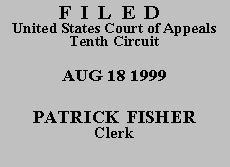

| IVA L. STALVEY,
Plaintiff-Appellant, v. KENNETH S. APFEL, Commissioner of Social Security Administration, Defendant-Appellee. |
|
Plaintiff Iva L. Stalvey appeals from an order of the district court affirming the Commissioner's determination that she is not entitled to Social Security benefits under either Title II or Title XVI. We affirm.
We review the Commissioner's decision to determine whether his factual findings were supported by substantial evidence in light of the entire record and to determine whether he applied the correct legal standards. See Castellano v. Secretary of Health & Human Servs., 26 F.3d 1027, 1028 (10th Cir. 1994). "Substantial evidence is such relevant evidence as a reasonable mind might accept as adequate to support a conclusion." Id. (quotations omitted). In the course of our review, we may "neither reweigh the evidence nor substitute our judgment for that of the agency." Casias v. Secretary of Health & Human Servs., 933 F.2d 799, 800 (10th Cir. 1991).
Ms. Stalvey alleged disability as of April 16, 1995, due to diabetes, a foot injury, acute anxiety, and depression. The administrative law judge (ALJ) determined that Ms. Stalvey was not disabled at step five of the five-step sequential process, see Williams v. Bowen, 844 F.2d 748, 750-52 (10th Cir. 1988), as she could perform light work.
On appeal, Ms. Stalvey contends substantial evidence does not support the ALJ's determination that she can perform light work, the ALJ applied the wrong legal standard in evaluating her mental limitations, and the testimony of the vocational expert (VE) is not substantial evidence as the hypothetical did not reflect her true limitations and was inconsistent with the Dictionary of Occupational Titles (DOT).
Contrary to Ms. Stalvey's contention, substantial evidence does support the ALJ's determination that she can perform light work. The record shows that Ms. Stalvey has had many problems with her diabetes. However, the record does not show any period of the prescribed length, see, 20 C.F.R. §§ 404.1509, 416.909, during which Ms. Stalvey was unable to work due to her diabetes. Additionally, the one time when Ms. Stalvey decompensated, possibly due to her diabetes, was prior to the time she claims disability.
The record fails to show that her foot injury is disabling. Ms. Stalvey hurt her foot in karate class in March 1995. The injury has improved since then. She does have mild degenerative changes in her foot with a calcaneal spur, but there is no indication that this is disabling.
Ms. Stalvey argues the ALJ should have ordered a consultative examination. An ALJ has "broad latitude" in determining whether to order a consultative examination. Diaz v. Secretary of Health & Human Servs., 898 F.2d 774, 778 (10th Cir. 1990). The ALJ should order one if the claimant has shown "a reasonable possibility that a severe impairment exists" and the examination would be "necessary or helpful to resolve the issue of impairment." Hawkins v. Chater, 113 F.3d 1162, 1167 (10th Cir.1997). No reason for an examination is present here.
Ms. Stalvey also contends the ALJ applied the wrong legal standard in evaluating her mental limitations. The ALJ must evaluate a mental impairment in accordance with 20 C.F.R. §§ 404.1520a, 416.920a by completing a Psychiatric Review Technique Form (PRT). The ALJ completed the PRT and determined that Ms. Stalvey was depressed and had slight restrictions in her daily activities and in maintaining social functioning, she seldom had deficiencies of concentration and had no episodes of deterioration or decompensation in work or work-like settings. These findings are compatible with the findings of two psychologists in 1995 and Dr. Inbody's 1995 consultative examination.
Ms. Stalvey contends the ALJ failed to consider Dr. Inbody's determination that she had a Global Assessment of Functioning (GAF) rating of 55. The GAF score represents Axis V of the Multiaxial Assessment system. See American Psychiatric Assoc., Diagnostic and Statistical Manual of Mental Disorders 25-30, (4th ed. 1994). The axial system of evaluation enables the clinician to comprehensively and systematically evaluate a client. See id. at 25. The GAF rates the client's "psychological, social, and occupational functioning." Id. at 30. The GAF is not an absolute determiner of ability to work. The ALJ properly considered that score along with the rest of the medical evidence in reaching his determination that Ms. Stalvey could perform light work.
Ms. Stalvey contends the testimony of the VE is not substantial evidence as the hypothetical posed to her did not reflect her true limitations. The hypothetical reflected the limitations the ALJ accepted. See Evans v. Chater, 55 F.3d 530, 532 (10th Cir. 1995) (ALJ's hypothetical questions to vocational expert "must include all (and only) those impairments borne out by the evidentiary record").
Ms. Stalvey argues that the exertional levels identified by the VE for the jobs she concluded Ms. Stalvey could perform do not agree with those assigned by the DOT. Although there may be some unexplained differences for some of the jobs the VE identified, the exertional level assigned by both the VE and the DOT to the position of food and beverage cashier is light, the level accepted by the ALJ as one Ms. Stalvey can perform. The VE testified that 1,813 such jobs are available in Oklahoma, with 139,008 available nationally. The ALJ properly determined that a sufficient number of those jobs existed in the local and national economy. See, e.g., Trimiar v. Sullivan, 966 F.2d 1326, 1330-32 (10th Cir. 1992). We find no error in the ALJ's determination that Ms. Stalvey could perform work which is available in both Oklahoma and the national economy in substantial numbers.
The judgment of the United States District Court for the Northern District of Oklahoma is AFFIRMED.
Entered for the Court
Senior Circuit Judge
*. This order and judgment is not binding precedent, except under the doctrines of law of the case, res judicata, and collateral estoppel. The court generally disfavors the citation of orders and judgments; nevertheless, an order and judgment may be cited under the terms and conditions of 10th Cir. R. 36.3.